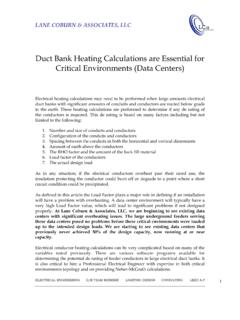Transcription of GREEN LUXURY: A CASE STUDY OF TWO GREEN HOTELS
1 RESEARCH. GREEN LUXURY: A CASE STUDY OF TWO GREEN HOTELS . Yong Han Ahn1 and Annie R. Pearce2. ABSTRACT. The hotel industry is beginning to implement GREEN design and construction practices, saving energy, water, and resources and thus helping to preserve the environment. In addition, GREEN building practices also can provide healthy and comfortable indoor environments to hotel occupants including guests and employees. However, there is the potential for conflict between GREEN building practices and hotel guests' satisfaction and comfort, as the conservation of resources could detract from the quality of a guest's visitor experience. This STUDY adopted a case STUDY approach to identify and analyze GREEN design and construction practices that create a GREEN and luxurious environment without damaging the HOTELS ' financial position. An in-depth literature review was conducted to identify GREEN design and construction practices, design features of premium HOTELS , and major design conflicts between the twin goals of GREEN building and a luxurious hotel environment.
2 Two LEED platinum HOTELS (the Proximity Hotel and the Bardessono Hotel, both in the United States) were selected and data collected on their GREEN design and construction practices, luxurious design features, and operation and maintenance practices from multiple sources, including the owner, designer, contractor, engineer, and LEED consultant. From the perspective of the entire lifecycle of the building, this data was analyzed to identify GREEN design and construction practices that not only provide a GREEN , luxurious environment but also enhance the HOTELS ' financial strength. KEYWORDS. GREEN building, GREEN design and construction practice, hotel industry, case STUDY INTRODUCTION. Throughout the design, construction, operation, and end-of-life-cycle processes that make up a building's life, the built environment of which it is a part exerts both positive and negative impacts on the earth, its resources, the people that live on it, and their communities. As part of the effort to reduce these negative environmental impacts and maximize benefits, the concept of sustainability has gained widespread acceptance over the past twenty years, encompass- ing ecological, economic and social aspects of the built environment (Ahn & Pearce 2007).
3 1. , LEED AP, Assistant Professor, Construction Management, Western Carolina University, Email: (Corresponding Author). 2. , LEED AP, Associate Professor, Myers-Lawson School of Construction, Virginia Tech, Email: 90 Journal of GREEN Building In the building sector, GREEN design and construction practices include: increasing efficiencies, thereby saving energy, water, and other resources; furnishing satisfying, productive, healthy, and high quality indoor spaces; using environmentally preferable materials; and educating building occupants about efficiency and conservation (Ahn & Pearce 2007; Kibert 2008). Hotel industry business owners seeking to be environmentally responsible, both for economic and financial efficiency, and to satisfy their own personal ethics are introducing GREEN build- ing practices (Tzschentke et al. 2004; Bader 2005). This trend towards GREEN HOTELS not only addresses environmental concerns by saving energy, water, and resources, but is also expected to improve guest satisfaction and comfort (Becker 2009; Millar & Baloglu 2008).
4 Guest sat- isfaction, intent to return, and likelihood to recommend a hotel are important factors for suc- cess in the hospitality industry. Therefore, in developing a new hotel the design team generally focuses on areas known to be strongly linked to these factors, namely the lobby, the guest- rooms, the bathrooms, food and beverages, spas, the outside environment, and the artwork displayed around the hotel (Heide & Gronhaung 2009). However, there is often the perception of some conflict between guest satisfaction and comfort and GREEN building practices in HOTELS that aspire to sustainability. According to Kirk (1995), this may arise as a result of the conservation of resources, including water and energy, which could detract from a guest's experience and comfort. For example, luxury HOTELS are generally more spacious and include plush or exotic materials, sophisticated lighting that feels warm and inviting, and bathrooms with large bathtubs and multiple showerheads (Schor 2008).
5 These luxury attributes of HOTELS are seldom compatible with GREEN building practices, which tend towards smaller spaces, and materials and products that are non-exotic, recycled, natural, or rapidly renewable, with increased use of fluorescent lighting to reduce energy use and an emphasis on the conservation of water (McLennan 2004; Becker 2009). In addition, a GREEN hotel is often assumed to be unattractive in appearance and uncomfortable (McLennan 2004). To counteract these tendencies and assumptions, it is therefore necessary to identify GREEN building practices that can be implemented over the building's entire life cycle to reduce its environmental impact, maximize social and economic opportunities, and improve guest satisfaction and comfort. The researchers therefore conducted a case STUDY of the Proximity Hotel in Greensboro, NC, and the Bardessono Hotel in Yountville, CA the only HOTELS in the United States at the time of this STUDY to have achieved the highest LEED rating of Plati- num while at the same time providing their guests with a comfortable and luxurious environ- ment in order to identify and analyze what types of GREEN building practices are appropriate and practicable for those seeking to implement GREEN building practices.
6 BACKGROUND STUDIES AND LITERATURE REVIEW. This section provides background for the concept of sustainability and GREEN practices in the building sector. Current hotel design features that provide luxury environments to guests and enhance their satisfaction are identified, along with the types of GREEN building practices that can be implemented in HOTELS to achieve the goals of sustainability. Finally, the conflicts between the twin goals of achieving sustainability while at the same time providing a luxuri- ous hotel environment are examined. Design Features for Luxury HOTELS The American term hotel was borrowed in the 1760s from the French term h tel, which originally referred to a nobleman's residence, large official building, or town hall (Becker, Volume 8, Number 1 91. 2009). Even though HOTELS in the USA were introduced in response to travellers' need for lodging, they represented high quality guesthouses that were above the level of the taverns and small inns commonly found at that time (Becker 2009).
7 Consequently, HOTELS tended to serve as architectural examples of American excellence and represented a distinctly American vision of mobility, civil society, and democracy (Sandoval-Strausz 2007), although this perception of HOTELS has faded somewhat over time due to the wide variety of industry market segmenta- tion, including a large increase in supply of inexpensive, lower quality chain HOTELS (Becker 2009). However, this trend has reversed in recent years, with several chain HOTELS creating boutique brands such as the W hotel that provide excellent service to guests who are looking for hotel experiences with style, service, comfort, and luxury that are personal, authentic, and creatively intriguing. These HOTELS often explore high fashion architecture, hotel design, and distinct interiors that influence hotel guest satisfaction, intent to return, and their likelihood to recommend a hotel (Heide & Gronhaung 2009). Based on reviewing a number of articles that discussed appropriate design features for luxury HOTELS , this STUDY identified key design features that can promote a hotel to luxury status (Becker, 2009; Heung et al.)
8 2006; Curtis 2001; Bernstein 1999; Cohen & Bodeker 2008; Heide & Gronhaung 2009; ). (Table 1). For example, common attributes of a luxury hotel include more space, plush or exotic materials, sophisticated lighting that feels warm and inviting, and bathrooms with large bathtubs and multiple showerheads (Becker 2009). These design features make guests' visits more comfortable but may create a perceived conflict with sustainability because major GREEN TABLE 1. Design features for luxury HOTELS . Design Features Design Features for Luxury HOTELS Lobby Design Social interaction spaces not only for guests but also for the local community Staged to provide a theatrical introduction to the environment and hotel spaces Guestroom Safety, comfort, privacy, quiet and spacious guestrooms Unique design details, technology, and controllable lighting Comfortable indoor environment Comfortable office spaces within the room Stylish furniture, plush materials and high tech entertainment devices Bathroom Spacious bathroom Deep tubs, his and her lavatories, walk-in showers, marble and chrome finishes Quality and appearance of amenities Technology such as a small plasma television, flexible lighting Artwork High quality artwork in guestrooms, hallways, lobbies, staircases, and elevators Gallery areas in the hotel Spa Attention to interior design, increasing guest relaxation Transition areas and generous public spaces Multiple relaxation areas.
9 Outdoor and indoor Environmental controls for guest comfort Spa cuisine-health, organic options Food & beverage Organic food and unusual food items Top quality food and beverage Landscaping Parks/gardens with trees and plants and exterior Open space with trees and plants environment Diverse colors and textures 92 Journal of GREEN Building building strategies focus on reducing humans' environmental footprint by reducing resource consumption to the necessities. Sometimes such luxury attributes may be perceived to be incompatible with GREEN building practices, which often focus on reducing resource con- sumption over the building life cycle to minimize environmental footprint. Sustainability and GREEN Building Practices GREEN buildings represent the response of the building sector to the need to minimize negative environmental, social, and economical impacts in the building sector. Through using GREEN building practices, it is possible to work toward the aim of meeting the needs and aspirations of today without compromising the ability of future generations to meet their own needs.
10 (Brudtlland 1989). To achieve a GREEN building, GREEN design and construction strategies should be incorporated at the planning stage to the demolition phase of the building. A GREEN building relies upon a fully integrated whole building approach that covers the entire phase of building cycle including design, construction, operation, and demolition (Boecker, et al. 2009). Mul- tiple studies have demonstrated how GREEN buildings that incorporate GREEN building practices offer benefits. For example, they can help mitigate building issues and problems, including environmental problems associated with existing buildings, and also provide healthier indoor environments to building users. Major benefits that can be provided by a GREEN building are shown in Table 2 below (Fisk 2000; Kats 2003a; Kats 2003b; Ding 2004; Bohdanowicz 2006;. Kibert 2008; USGBC 2009; Boecker, et al. 2009; Ahn 2010; Ahn, et al. 2011): To achieve these benefits, GREEN building practices continue to evolve, with considerable advances in the field during the first decade of the 21st century (McLennan 2004).




